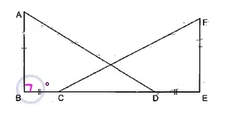In triangle ABC,po∈tsD,EandF are taken on the sides BC,CAandAB, respectigvely, such that BDDC=CEEA=AFFB=n. Prove that _(DEF)=n2−n+1((n+1)2)ABC.Solution in Tamil
Take A as the origin and last the postion vectors of point B and C be →band→c, Respectively.
Therefore, the position vectors, of D, E and F are, respectively, n→c+→bn+1,→cn+1andn→bn+1. Therefore,
−−→ED=−−→AD−−−→AE=(n−1)→c+→bn+1and−−→EF=n→b−→cn+1
vector area of ΔABC=12(→b×→c)
vector area of ΔDEF=12(−−→EF×−−→ED)
12(n+1)2[(n→b−→c)×{(n−1)→c+→b}]
=12(n+1)2[(n2−n)→b×→c+→b×→c]
12(n+1)2[(n2−n+1)(→b×→c)]=n2−n+1(n+1)2ΔABC
Topper's Solved these Questions
- BOOK - CENGAGECHAPTER - DIFFERENT PRODUCTS OF VECTORS AND THEIR GEOMETRICAL APPLICATIONS EXERCISE - Exercise337videos
DIFFERENT PRODUCTS OF VECTORS AND THEIR GEOMETRICAL APPLICATIONS
- BOOK - CENGAGECHAPTER - DETERMINANTSEXERCISE - All Questions268videos
DETERMINANTS
- BOOK - CENGAGECHAPTER - DIFFERENTIAL EQUATIONSEXERCISE - Question Bank7videos
DIFFERENTIAL EQUATIONS
Similar Questions
Find |→a|and∣∣→b∣∣, if (→a+→b)⋅(→a−→b)=8and|→a|=8∣∣→b∣∣.
03:07View SolutionStatement 1: If bc+qr=ca+rp=ab+pq=−1, then|apapbqbqcrcr|=0(abc,pqr≠0). Statement 2: if system of equations a1x+b1y+c1=0,a2x+b2y+c2=0,a3x+b2y+c3=0 has non -trivial solutions |a1b1c1a2b2c2a3b3c3|=0
08:03View SolutionFind the real value of m for which the subsititution y=um will transform the differential equation 2x4ydydx+y4=4x6 in to a homogenous equation.
03:25View SolutionIf D,E,F are the mid-points of the sides BC,CAandAB respectively of a triangle ABC, prove by vector method that AreaofDEF=14(areaofABC).
02:07View SolutionIn triangle ABC,po∈tsD,EandF are taken on the sides BC,CAandAB, respectigvely, such that BDDC=CEEA=AFFB=n. Prove that _(DEF)=n2−n+1((n+1)2)ABC.
View SolutionD, E, F are the mid-point of the sides BC, CA and AB respectively of ABC. Then DEF is congruent to triangle. ABC (b) AEF (c) BFD, CDE (d) AFE, BFD, CDE
Given : D, E, F are the mid-point of the sides BC, CA and AB .
06:27View SolutionIn Figure, AB⊥BEandFE⊥BE.If BC=DEandAB=EF, then ABD is congruent to:
(a)EFC
(b) ECF
(c) CEF
(d) FEC
 02:38View Solution
02:38View Solutionif a,b,c,d,e and f are six real numbers such that a+b+c=d+e+f a2+b2+c2=d2+e2+f2 and a3+b3+c3=d3+e3+f3 , prove by mathematical induction that an+bn+cn=dn+en+fn∀n∈N.
07:47View SolutionD,E,andF are the middle points of the sides of the triangle ABC , then (a) centroid of the triangle DEF is the same as that of ABC (b) orthocenter of the tirangleDEF is the circumcentre of ABC
03:58View SolutionIn triangle ABC ,points D,EandF are taken on the sides BC,CAandAB, respectively, such that BDDC=CEEA=AFFB=n. Prove that △DEF=n2−n+1(n+1)2△(ABC).
07:02View SolutionFrom a point O inside a triangle ABC, perpendiculars OD,OEandOf are drawn to rthe sides BC,CAandAB, respecrtively. Prove that the perpendiculars from A,B,andC to the sides EF,FDandDE are concurrent.
02:50View SolutionThe sides AB and CD of a parallelogram ABCD are bisected at EandF . Prove that EBFD is a parallelogram.
04:58View SolutionIf D,E,F are the mid-points of the sides BC,CAandAB respectively of a triangle ABC, prove by vector method that AreaofDEF=14(areaofABC).
03:05View SolutionAD, BE and CF, the altitudes of ABC are equal. Prove that ABC is an equilateral triangle.
03:03View SolutionD, E, F are the mid-point of the sides BC, CA and AB respectively of △ABC. Then DEF is congruent to triangle.
(a)ABC
(b) AEF
(c) BFD, CDE
(d) AFE, BFD, CDE11:32View SolutionIn Figure, AB⊥BE and FE ⊥BE. If BC=DE and AB=EF, then ABD is congruent to: EFC (b) ECF (c) CEF (d) FEC
07:14View Solution

